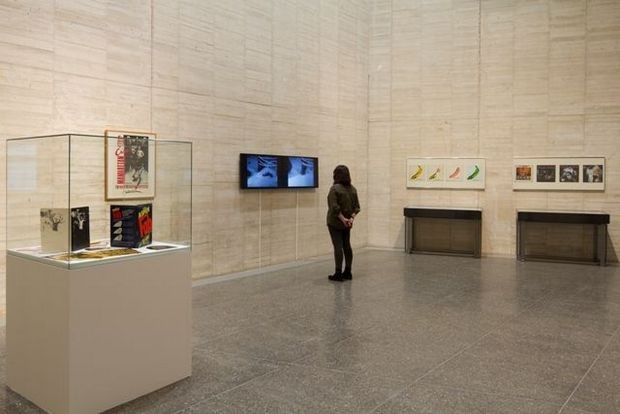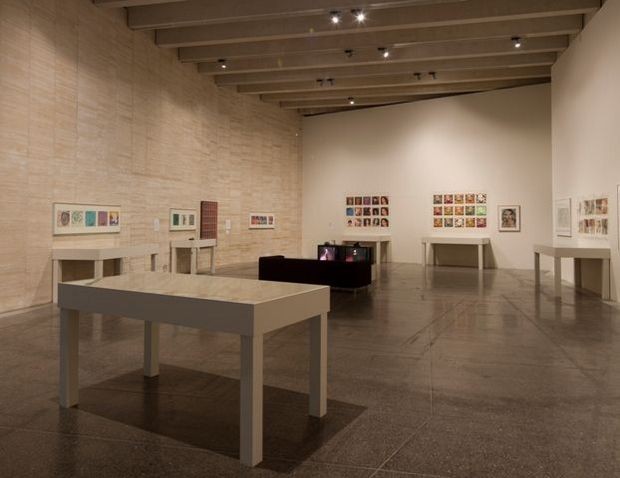All Yesterday’s Parties. Andy Warhol, Music and Vinyls (1949-1987)
07 May - 04 Sep 2016

ANDY WARHOL. From the series ROLLING STONES – LOVE YOU LIVE (1975). Collection Thaddaeus Ropac. Paris-Salzburg
ALL YESTERDAY’S PARTIES. ANDY WARHOL, MUSIC AND VINYLS (1949-1987)
Hall 3
7 May - 4 September 2016
Curatorship: F. Javier Panera
Coordination: Carlos Ordás
All Yesterday’s Parties. Andy Warhol, Music and Vinyls (1949-1987) traces a genealogic relationship between popular art and music in the second half of the 20th century through more than 200 pieces, including LP album covers, books, magazines, posters, photographs, prints, drawings, films, video installations, screen tests, musical videos and diverse objects and documents related to the artistic universe of Warhol throughout almost four decades.
The starting point for this show is an aspect of the artistic production of Andy Warhol (Pittsburgh, USA, 1928 - New York, USA, 1987) that was considered to be of marginal importance until not so long ago: his contribution to the history of graphic design in the music industry through the design of album covers. Andy Warhol created over 60 covers for 33 and 45 RPM records of all musical genres between 1949 and 1987. Graphic design for music was an activity that accompanied him throughout his career, from his youth—his first design dates back to 1949, when he was just twenty-one years old and was still not recognized as an artist—, until well into his adulthood. In his last months of life, between 1986 and 1987, he created album covers for the likes of John Lennon, Aretha Franklin or Debbie Harry. An analysis of the designs in many of these covers reveals an anticipation of some formal and iconographical solutions that Warhol would later add to his pictorial and cinematographic production. This makes them especially valuable to researchers and invites transversal readings of his work.
Through these covers one could write a history of musical taste in United States from the post-war period to the last third of the decade of the eighties, covering classical music, opera and ballet, as well as jazz, minimalism, experimental music, rock, pop, soul, disco music, punk or the new wave.
All Yesterday"s Parties. Andy Warhol, Music and Vinyls (1949-1987) seeks to demonstrate that music—particularly pop music—was one of the emotional, iconographic and conceptual foundations on which the artistic production of the father of pop art was built. A sometimes invisible component, which is, however, essential to understand his creative process and some of the most significant themes of his work.
From Appropriation and Seriality—born under the influence of musicians such as John Cage and LaMonte Young at the beginning of the sixties — to the updating of the Wagnerian concept of "total art work"—embodied in pioneering multimedia shows such as Exploding Plastic Inevitable, with The Velvet Undergroun —; from celebrity worship—captured in his portraits of pop and rock stars such as Mick Jagger, Diana Ross and Debbie Harry—to his active participation in media directly or collaterally linked to the music industry; from publishing projects such as Interview magazine, the direction and production of video clips for bands of the eighties—such as The Cars or Curiosity Killed The Cat—to innovative television programs, such as Fifteen Minutes, that he produced for the cable television network MTV.
Like other contemporary artists, such as Ray Johnson, Richard Hamilton and Peter Blake, Andy Warhol belongs to the first generation of artists who grew up listening to music, which thus became part of their educational path since their youth. Warhol is also one of the first to include rock stars in the iconography of his paintings. In fact, the portrait of Elvis Presley already appears in his first silk-screen prints of 1962. However, throughout his career Warhol exhibited a vast musical culture encompassing both the Wagnerian opera or Hollywood musicals, and avant-garde or pop music: from Elvis Presley to Maria Callas, from John Cage to The Velvet Underground and from Count Basie to Michael Jackson, as well as icons such as Nico, Mick Jagger, John Lennon or Debbie Harry, one of his last muses.
The exhibition is divided into several thematic sections arranged in chronological order that intersect to provide an overview, as complete as possible, of the role played by music in Andy Warhol’s creative process. In each chapter, the album covers are displayed next to works in different media—photographs, drawings, prints, posters, films, video installations—created by Warhol himself, as well as by artists who collaborated with him in different periods of his career such as Ronald Nameth, Nat Finkelstein, Christopher Makos, Hervé Gloaguen, Richard Bernstein, and Dan Munroe. This arrangement helps us to understand how the graphic design for the music industry and the visual production of this artist informed one another in the most significant moments of his life.
Hall 3
7 May - 4 September 2016
Curatorship: F. Javier Panera
Coordination: Carlos Ordás
All Yesterday’s Parties. Andy Warhol, Music and Vinyls (1949-1987) traces a genealogic relationship between popular art and music in the second half of the 20th century through more than 200 pieces, including LP album covers, books, magazines, posters, photographs, prints, drawings, films, video installations, screen tests, musical videos and diverse objects and documents related to the artistic universe of Warhol throughout almost four decades.
The starting point for this show is an aspect of the artistic production of Andy Warhol (Pittsburgh, USA, 1928 - New York, USA, 1987) that was considered to be of marginal importance until not so long ago: his contribution to the history of graphic design in the music industry through the design of album covers. Andy Warhol created over 60 covers for 33 and 45 RPM records of all musical genres between 1949 and 1987. Graphic design for music was an activity that accompanied him throughout his career, from his youth—his first design dates back to 1949, when he was just twenty-one years old and was still not recognized as an artist—, until well into his adulthood. In his last months of life, between 1986 and 1987, he created album covers for the likes of John Lennon, Aretha Franklin or Debbie Harry. An analysis of the designs in many of these covers reveals an anticipation of some formal and iconographical solutions that Warhol would later add to his pictorial and cinematographic production. This makes them especially valuable to researchers and invites transversal readings of his work.
Through these covers one could write a history of musical taste in United States from the post-war period to the last third of the decade of the eighties, covering classical music, opera and ballet, as well as jazz, minimalism, experimental music, rock, pop, soul, disco music, punk or the new wave.
All Yesterday"s Parties. Andy Warhol, Music and Vinyls (1949-1987) seeks to demonstrate that music—particularly pop music—was one of the emotional, iconographic and conceptual foundations on which the artistic production of the father of pop art was built. A sometimes invisible component, which is, however, essential to understand his creative process and some of the most significant themes of his work.
From Appropriation and Seriality—born under the influence of musicians such as John Cage and LaMonte Young at the beginning of the sixties — to the updating of the Wagnerian concept of "total art work"—embodied in pioneering multimedia shows such as Exploding Plastic Inevitable, with The Velvet Undergroun —; from celebrity worship—captured in his portraits of pop and rock stars such as Mick Jagger, Diana Ross and Debbie Harry—to his active participation in media directly or collaterally linked to the music industry; from publishing projects such as Interview magazine, the direction and production of video clips for bands of the eighties—such as The Cars or Curiosity Killed The Cat—to innovative television programs, such as Fifteen Minutes, that he produced for the cable television network MTV.
Like other contemporary artists, such as Ray Johnson, Richard Hamilton and Peter Blake, Andy Warhol belongs to the first generation of artists who grew up listening to music, which thus became part of their educational path since their youth. Warhol is also one of the first to include rock stars in the iconography of his paintings. In fact, the portrait of Elvis Presley already appears in his first silk-screen prints of 1962. However, throughout his career Warhol exhibited a vast musical culture encompassing both the Wagnerian opera or Hollywood musicals, and avant-garde or pop music: from Elvis Presley to Maria Callas, from John Cage to The Velvet Underground and from Count Basie to Michael Jackson, as well as icons such as Nico, Mick Jagger, John Lennon or Debbie Harry, one of his last muses.
The exhibition is divided into several thematic sections arranged in chronological order that intersect to provide an overview, as complete as possible, of the role played by music in Andy Warhol’s creative process. In each chapter, the album covers are displayed next to works in different media—photographs, drawings, prints, posters, films, video installations—created by Warhol himself, as well as by artists who collaborated with him in different periods of his career such as Ronald Nameth, Nat Finkelstein, Christopher Makos, Hervé Gloaguen, Richard Bernstein, and Dan Munroe. This arrangement helps us to understand how the graphic design for the music industry and the visual production of this artist informed one another in the most significant moments of his life.



